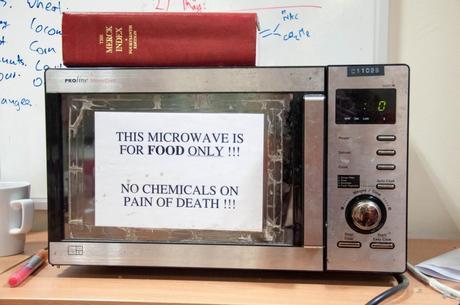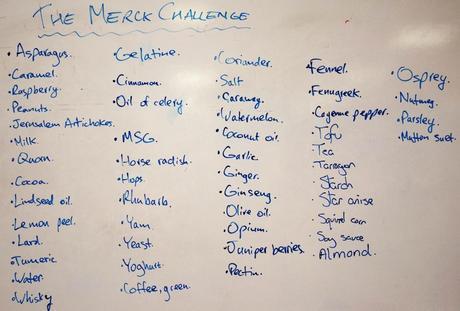Sorry things have been so quiet around here; it's been a hectic month! Here's something silly born of an unusual conversation over coffee.

The office microwave: unnecessary chemophobia?
The Merck Index, along with Fieser and Fieser's Reagents for Organic Synthesis, Greene’s Protective Groups, March’s Advanced Organic Chemistry and Amarego’s Purification of Laboratory Chemicals is one of those books that any self-respecting organic research group will have a copy of. It’s an iconic reference work, although its usefulness has definitely waned in recent decades with the rise of the internet, Scifinder/Reaxys/Chemspider and Wikipedia. As Derek reported before Christmas, it was recently acquired by the RSC, who have just released an updated edition. I mostly use mine to pass the time waiting for NMRs to run, or when I need a more reputable reference than Wikipedia for a paper or report.[1] However, all of that changed last week when a tea break conversation sparked a bizarre new game: The Merck Index Challenge.
Anyone who’s ever flicked through a copy will probably have noticed that amongst all the drugs, solvents, salts and plants there are a number of… aberrant… entries. For example, Whiskey. And Lard.[2] And Raspberries. And Quorn. And Milk. Thus, the question arose: could a meal be constructed using only ingredients from the Merck Index? Better yet, could one manage three courses?

The search for items! This list was pieced together over a week of gruelling research.
Here are the edible entries I’m aware of (please let me know what I’ve missed in the comments!):
Almond
Aparagus
Caramel
Caraway
Cayenne Pepper
Cinnamon
Cocoa
Coconut Oil
Coriander
Fennel
Fenugreek
Garlic
Gelatine
Ginger
Ginseng
Green Coffee
Hops
Horse Radish
Jerusalem Artichokes
Juniper Berries
Lard
Lemon Peel
Lindseed Oil
Milk
MSG
Mutton Suet
Nutmeg
Oil of Celery
Olive Oil
Opium
Osprey[3]
Parsley
Peanuts
Pectin
Quorn
Raspberries
Rhubarb
Salt
Soy Sauce
Squirrel Corn
Star Anise
Starch
Tarragon
Tea
Tofu
Tumeric
Water
Watermelon
Whiskey
Yam
Yeast
Yoghurt
I've avoided listing various sugars, salts, proteins etc to keep the list looking like something that could actually be found in a recipe.
I'm not sure what to actually do with this list; my first though was some kind of crowd-sourced version of Ready Steady Cook (not sure what the equivalent US TV show is) where I'd take suggestions for a meal and then make it and take a photo for y'all, but I'm pretty busy right now and trying to empty out my cupboards ahead of moving out of my flat in a month. Maybe some other time. Anyway, I though this might be fun to share, and feel free to make suggestions and point out things I've missed.
- Having said that, after seeing PIKHAL reference in a J. Med. Chem. Paper last year, I’m not even convinced it’ll be useful for this for much longer.
- Interestingly, a melting point of 38-46 ºC is given for lard, providing a useful alternative to the Sell By Date for assessing its quality. Strictly speaking, a mixed melting point with an authentic sample should be used.
- This is in there, but rather than a bird of prey, it's a tradename for a pesticide.
